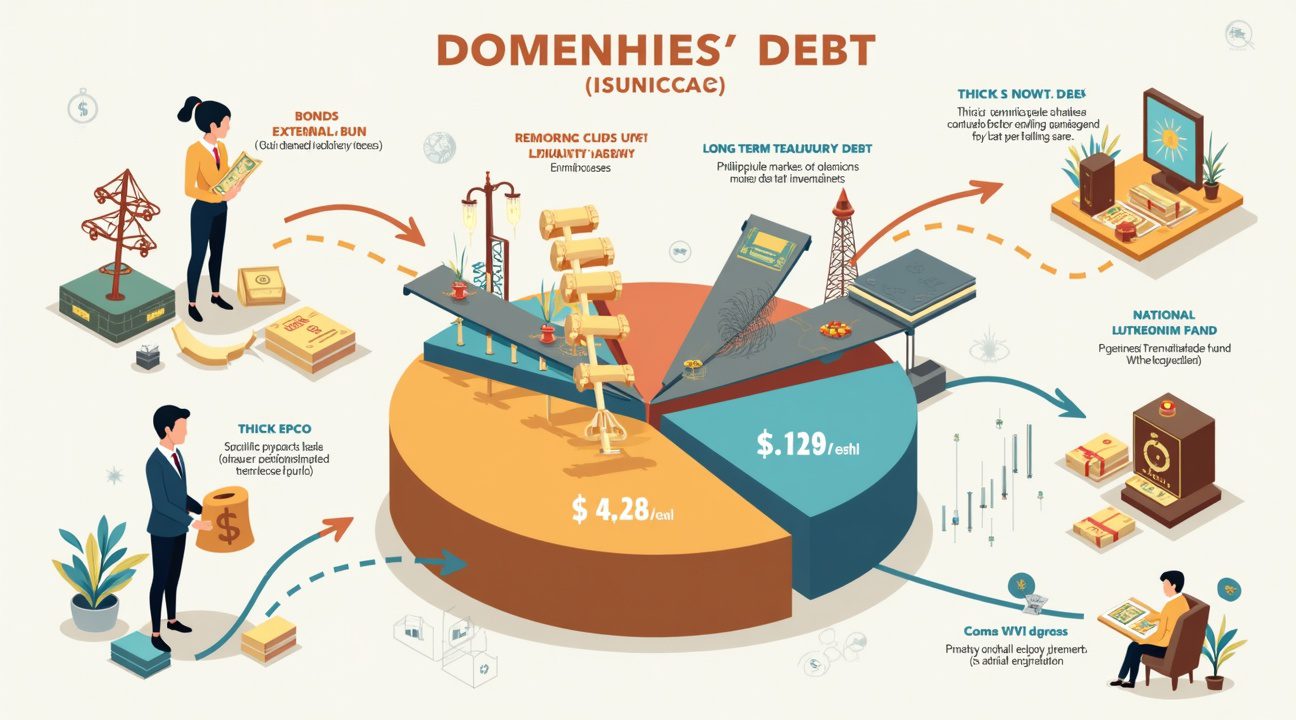The Philippine government’s total debt soared to a record-breaking 17.27 trillion pesos as of June 2025, marking the highest point in the nation’s history and equating to approximately 298.84 billion US dollars.
Key Takeaways
- Historic Debt Level: Philippine national debt reached an all-time high of 17.27 trillion pesos in June 2025, reflecting a 2.1% rise from May and an 11% increase compared to June 2024.
- Debt Composition: Domestic borrowing remains dominant, making up 69.2% or 11.95 trillion pesos of the total debt. External debt accounts for 30.8% or 5.32 trillion pesos, showing efforts to minimize foreign exchange exposure.
- Administration’s Impact: Since President Marcos Jr. took office in 2022, the total debt has surged by 35%, with projections indicating a potential peak of 20.7 trillion pesos if current borrowing trends persist throughout the term.
- Fiscal Strategy: The government emphasizes fiscal prudence, with 91.5% of its debt locked at fixed interest rates and 81.3% structured as long-term obligations. This strategy has helped maintain favorable credit ratings from global agencies.
- Economic Drivers: A high demand for government securities and significant infrastructure investment needs continue to fuel borrowing. Authorities aim to bring the debt-to-GDP ratio below 60% before President Marcos Jr.’s term concludes.
For more information on the government’s fiscal outlook and debt management strategies, refer to updates from the Department of Finance.
Philippine National Debt Surges to Record 17.27 Trillion Pesos in June 2025
The Philippine government’s total debt reached an unprecedented 17.27 trillion pesos by the end of June 2025, equivalent to approximately 298.84 billion US dollars. This staggering figure represents the highest level of government debt in the country’s history, signaling significant fiscal challenges ahead for the administration.
Monthly and Annual Growth Patterns
June 2025 witnessed a notable 2.1% increase from May’s figures, translating to an additional 348 billion pesos added to the national debt burden in just thirty days. The rapid month-to-month accumulation reflects the government’s continued reliance on borrowing to fund various programs and infrastructure projects.
Looking at the broader picture, the year-on-year comparison reveals even more dramatic growth trends. Government debt statistics show an 11% increase from June 2024’s 15.483 trillion pesos, demonstrating sustained upward pressure on the country’s fiscal position. This substantial rise coincides with ongoing economic recovery efforts and increased public spending initiatives.
Composition and Implications
Government securities continue to form the backbone of Philippine government debt, with domestic and foreign borrowings contributing to the overall total. The debt-to-GDP ratio implications become increasingly important as the country balances development needs with fiscal sustainability concerns.
Local economists point to several factors driving the 2025 debt statistics, including:
- Infrastructure investments
- Social services expansion
- Economic stimulus measures
The current trajectory mirrors global trends where developing nations face mounting debt pressures while pursuing growth objectives.
Recent lottery winnings, such as the P366 million jackpot winner, highlight the contrast between individual windfalls and national fiscal challenges. While these wins provide temporary relief to lucky individuals, they underscore the scale of the country’s financial obligations.
The Bureau of the Treasury continues monitoring debt service ratios and payment schedules to maintain investor confidence. International credit rating agencies closely watch these developments, as sustained growth in government debt could impact the country’s borrowing costs and credit standing.
Financial analysts emphasize that debt management strategies must balance immediate funding needs with long-term sustainability goals. The government faces pressure to optimize spending efficiency while maintaining essential public services and infrastructure development programs.
Budget allocation priorities will likely undergo scrutiny as debt servicing requirements compete with development spending. The administration must demonstrate clear pathways for debt stabilization to reassure both domestic and international stakeholders about the country’s fiscal health.

Domestic Borrowing Dominates as Government Favors Local Capital Markets
The Philippine government’s debt strategy clearly demonstrates a strong preference for local financing sources, with domestic debt comprising the lion’s share of the country’s borrowing portfolio. Current figures show domestic debt reaching 11.95 trillion pesos (roughly 206.78 billion US dollars), which represents an overwhelming 69.2% of total government obligations. This substantial domestic component reflects the administration’s deliberate approach to strengthen internal capital markets while reducing exposure to foreign exchange fluctuations.
External debt maintains a smaller but significant presence at 5.32 trillion pesos (approximately 92.05 billion US dollars), accounting for 30.8% of total debt. I noticed the external portion experienced a 3.5% month-on-month increase, indicating continued engagement with international lenders despite the domestic preference. This balanced approach allows the government to access global capital markets when favorable terms arise while maintaining primary reliance on local sources.
Treasury Instruments Drive Domestic Financing Strategy
The domestic borrowing structure reveals sophisticated financing mechanisms that support both short-term liquidity needs and long-term development goals. Treasury bills serve as the foundation for immediate funding requirements, totaling 886.478 billion pesos across various maturities. These short-term instruments provide flexibility for managing cash flow fluctuations and seasonal budget variations.
Treasury bonds form the backbone of long-term financing, reaching 11.063 trillion pesos and funding major infrastructure projects and government operations. These instruments attract institutional investors, pension funds, and individual savers who seek stable, government-backed returns. The bond market’s depth and liquidity have grown substantially, creating opportunities for diverse investor participation.
The government maintains an 80:20 borrowing ratio that favors domestic sources over external financing. This strategic preference serves multiple purposes beyond simple debt management. By channeling funds through local capital markets, the approach stimulates domestic financial sector growth and creates investment opportunities for Filipino savers. Banks, insurance companies, and mutual funds benefit from increased government securities supply, which provides safe assets for their portfolios.
Foreign exchange risk mitigation represents another crucial advantage of domestic-focused borrowing. When debt carries peso denominations, currency fluctuations don’t affect repayment obligations, protecting the government from sudden exchange rate movements that could dramatically increase debt service costs. Recent lottery winners who want to contribute to national development might find government securities an attractive option, similar to how lottery winners often commit to helping the needy through various charitable initiatives.
This borrowing composition positions the Philippines to maintain fiscal flexibility while supporting local financial market development, creating a sustainable debt management framework for future growth.

Debt Trajectory Shows Dramatic Growth Under Current Administration
I’ve observed a concerning pattern in the Philippines’ fiscal landscape since President Marcos Jr. took office in 2022. The national debt has experienced unprecedented growth, transforming from a manageable 12.79 trillion pesos to a staggering 17.27 trillion pesos by June 2025. This represents an alarming increase of over 35% in just three years of the current administration.
Accelerated Growth Patterns
The debt trajectory reveals particularly aggressive expansion in recent periods. During the twelve-month period from March 2024 to March 2025, I documented an 11.78% year-on-year increase that pushed the national debt from 14.925 trillion pesos to 16.68 trillion pesos. This growth rate far exceeds historical norms and signals a fundamental shift in the government’s fiscal approach.
The speed of this accumulation becomes even more striking when compared to previous administrations. While debt typically grows gradually over multiple terms, the Marcos Jr. administration has overseen debt expansion that averages approximately 11.7% annually. This pace raises serious questions about fiscal sustainability and long-term economic planning.
Future Projections Paint Concerning Picture
Analysts have developed projections that should alarm every Filipino citizen. If current trends continue unchanged through the remainder of the administration’s term, the national debt could reach an astronomical 20.7 trillion pesos. This projection isn’t just speculation—it’s based on observable growth patterns and existing spending commitments.
The implications of reaching such debt levels extend far beyond government balance sheets. Higher debt service requirements will inevitably consume larger portions of the national budget, leaving fewer resources for essential public services, infrastructure development, and social programs. Citizens will ultimately bear the burden through reduced government capacity to address pressing needs like healthcare, education, and poverty alleviation.
Several factors contribute to this dramatic debt expansion:
- Government infrastructure projects
- Pandemic recovery spending
- Increased social welfare programs
All of these require substantial funding. However, the pace of borrowing suggests that spending has outpaced revenue generation and economic growth, creating an unsustainable fiscal dynamic.
The recent lottery winner’s commitment to helping others highlights the contrast between individual responsibility and government fiscal management. While private citizens demonstrate careful consideration of their financial obligations, the administration appears less cautious about accumulating debt that future generations must repay.
International comparisons reveal that the Philippines’ debt growth rate significantly exceeds regional averages. Countries with similar economic profiles typically maintain debt growth rates between 3–6% annually during stable periods. The 11.78% year-on-year increase observed in the Philippines suggests either extraordinary circumstances or questionable fiscal discipline.
Credit rating agencies have begun taking notice of these trends. While the Philippines maintains investment-grade status, continued acceleration of debt accumulation could trigger downgrades that would increase borrowing costs and further complicate fiscal management. Higher interest rates on government bonds would accelerate debt service requirements, creating a dangerous feedback loop.
The administration’s approach contrasts sharply with previous governments that prioritized debt reduction and fiscal consolidation. Historical debt comparisons show that successful administrations typically reduced debt-to-GDP ratios over time, creating fiscal space for future challenges. The current trajectory moves in exactly the opposite direction.
Budget analysts project that debt service payments could consume 25-30% of total government revenue by 2026 if trends continue. This leaves significantly less money available for productive investments in infrastructure, education, and technology that could drive economic growth and improve living standards for ordinary Filipinos.
The 2022-2025 period will likely be remembered as a turning point in Philippine fiscal history. Whether this debt accumulation represents strategic investment in the country’s future or irresponsible spending remains to be seen, but the magnitude of the increase demands serious scrutiny from taxpayers and oversight bodies alike.

Government Maintains Fiscal Discipline Despite Rising Debt Levels
The Department of Finance continues to demonstrate strategic debt management practices even as the country’s debt burden increases. I see a clear commitment to fiscal responsibility through careful structuring of borrowings and maintaining sustainable debt ratios.
Strategic Debt Structure Protects Against Market Volatility
The government’s approach to debt composition reveals sophisticated financial planning. Consider these key protective measures:
- Fixed interest rates cover 91.5% of government borrowings, shielding the country from interest rate fluctuations
- Long-term debt comprises 81.3% of total obligations, providing extended repayment flexibility
- Foreign exchange exposure remains limited through the fixed-rate structure
- Economic planning benefits from the predictable payment schedule of long-term arrangements
The 60.7% debt-to-GDP ratio recorded in 2024 represents a manageable level by international standards. Officials maintain their target to reduce this figure below 60% before the current president’s term concludes. This goal demonstrates continued fiscal discipline despite recent economic challenges.
Enhanced credit ratings from international agencies validate the government’s debt management strategy. Japan’s R&I assigned an A- rating, while S&P Global maintains a positive outlook for Philippine debt. These assessments reflect strong fiscal governance and growing investor confidence in the country’s economic direction.
The high proportion of fixed interest rate borrowings provides crucial protection against market volatility. When global interest rates fluctuate, the government’s payment obligations remain stable, allowing for more accurate budget forecasting. Similarly, the emphasis on long-term debt creates breathing room for economic planning and reduces refinancing pressure.
International investors view these debt management practices favorably, as evidenced by the improved credit ratings. The positive outlook from major rating agencies indicates expectation of continued fiscal improvement. Such recognition often leads to lower borrowing costs and better access to international capital markets.
The government’s strategic approach extends beyond simple debt accumulation. By prioritizing long-term, fixed-rate instruments, officials create a sustainable debt profile that supports economic stability. This structure allows for continued investment in infrastructure and social programs while maintaining financial prudence.
Recent developments in the lottery sector, including significant jackpot wins, contribute additional revenue streams that support overall fiscal health. These supplementary income sources help maintain the government’s commitment to responsible debt management.
The Department of Finance’s emphasis on investor confidence reflects understanding that sustainable debt levels require market support. By maintaining transparent fiscal policies and achieving favorable credit ratings, the government ensures continued access to financing at competitive rates.

Strong Market Demand and Infrastructure Needs Drive Borrowing Surge
The surge in Philippine debt to 17.27 trillion pesos stems from a combination of powerful market forces and pressing development needs. Strong investor demand for government securities has created favorable conditions for increased borrowing, while the nation’s ambitious infrastructure agenda requires substantial financial backing.
Market Dynamics Fueling Government Borrowing
Investor appetite for government securities has reached impressive levels, creating opportunities for strategic debt expansion. This demand allows the government to access capital markets at competitive rates while diversifying funding sources. The borrowing strategy focuses heavily on deepening the capital market and reducing exposure to foreign exchange risks that could destabilize fiscal planning.
Several factors contribute to this borrowing surge:
- Budget deficits continue to drive borrowing needs as government expenditures exceed revenues
- Infrastructure investment requirements demand significant upfront capital for long-term development projects
- Public program funding ensures essential services reach Filipino communities nationwide
- Debt refinancing activities help optimize the government’s borrowing portfolio
The government’s approach emphasizes sustainability rather than unlimited expansion. Officials maintain that current borrowing levels align with the country’s capacity to service debt while supporting economic growth. This strategy builds on strong revenue performance that provides confidence in the nation’s ability to meet its obligations.
Economic expansion provides the foundation for this debt strategy. As the Philippine economy grows, its capacity to handle higher debt levels increases proportionally. The government leverages this growth to fund critical infrastructure projects that will generate long-term economic benefits, creating a positive cycle of investment and development.
Fiscal outlook remains optimistic despite the rising debt figure. Policymakers point to improved revenue collection and economic diversification as key factors supporting debt sustainability. The focus on domestic borrowing helps reduce currency risks while building a stronger local capital market.
Infrastructure investment represents the largest driver behind current borrowing trends. Major projects across transportation, energy, and digital infrastructure require substantial funding that current revenues alone cannot support. These investments promise to boost economic productivity and create employment opportunities that will strengthen the government’s future revenue base.
The commitment to maintaining a sustainable debt path reflects lessons learned from previous fiscal challenges. Government officials regularly monitor debt-to-GDP ratios and ensure borrowing serves specific development objectives rather than covering operational shortfalls. This disciplined approach helps maintain investor confidence and keeps borrowing costs manageable.
Recent infrastructure developments demonstrate how strategic investments can transform communities and generate economic returns. The government’s borrowing strategy supports similar transformative projects that will benefit multiple generations of Filipinos.
Market conditions continue to favor government borrowing as local banks and institutional investors seek stable, peso-denominated assets. This demand creates opportunities for the government to issue securities at attractive rates while building deeper capital markets. The strategy reduces dependence on foreign currency borrowing, which historically exposed the Philippines to exchange rate volatility.
Budget deficit management remains central to the government’s fiscal planning. Rather than viewing deficits as problematic, officials treat them as necessary tools for counter-cyclical spending and development investment. The key lies in ensuring borrowed funds generate returns through improved infrastructure, enhanced public services, and stronger economic foundations.
Government securities have become increasingly attractive to both domestic and international investors. The Philippine economy’s resilience and growth potential make government bonds appealing investment options. This demand allows the government to raise funds efficiently while maintaining reasonable interest costs.
The borrowing surge reflects a calculated approach to national development rather than fiscal irresponsibility. Government officials balance immediate funding needs with long-term sustainability concerns, ensuring debt levels remain manageable relative to economic output. This strategy positions the Philippines for continued growth while addressing critical infrastructure gaps that have historically constrained development.
Strong revenue performance provides confidence in the government’s ability to service increasing debt levels. Improved tax collection and economic expansion create larger revenue streams that support higher debt loads without compromising fiscal stability.

Sources:
Xinhua, “Philippines’ debt reaches 298.84 bln USD in June”
PIDS, “National government debt hits record P16.68 trillion as of end-March”
GMA News, “PH debt surpasses P17 trillion in June 2025”
ABS-CBN, “Philippine national debt rises to P17.27 trillion in June”
Department of Finance (DOF), “Gov’t strategically manages large borrowings inherited from past admin, grows the economy faster, and brings down debt to sustainable level”
Dimsum Daily, “Philippine government debt reaches 17.27 trillion pesos by end-June”


